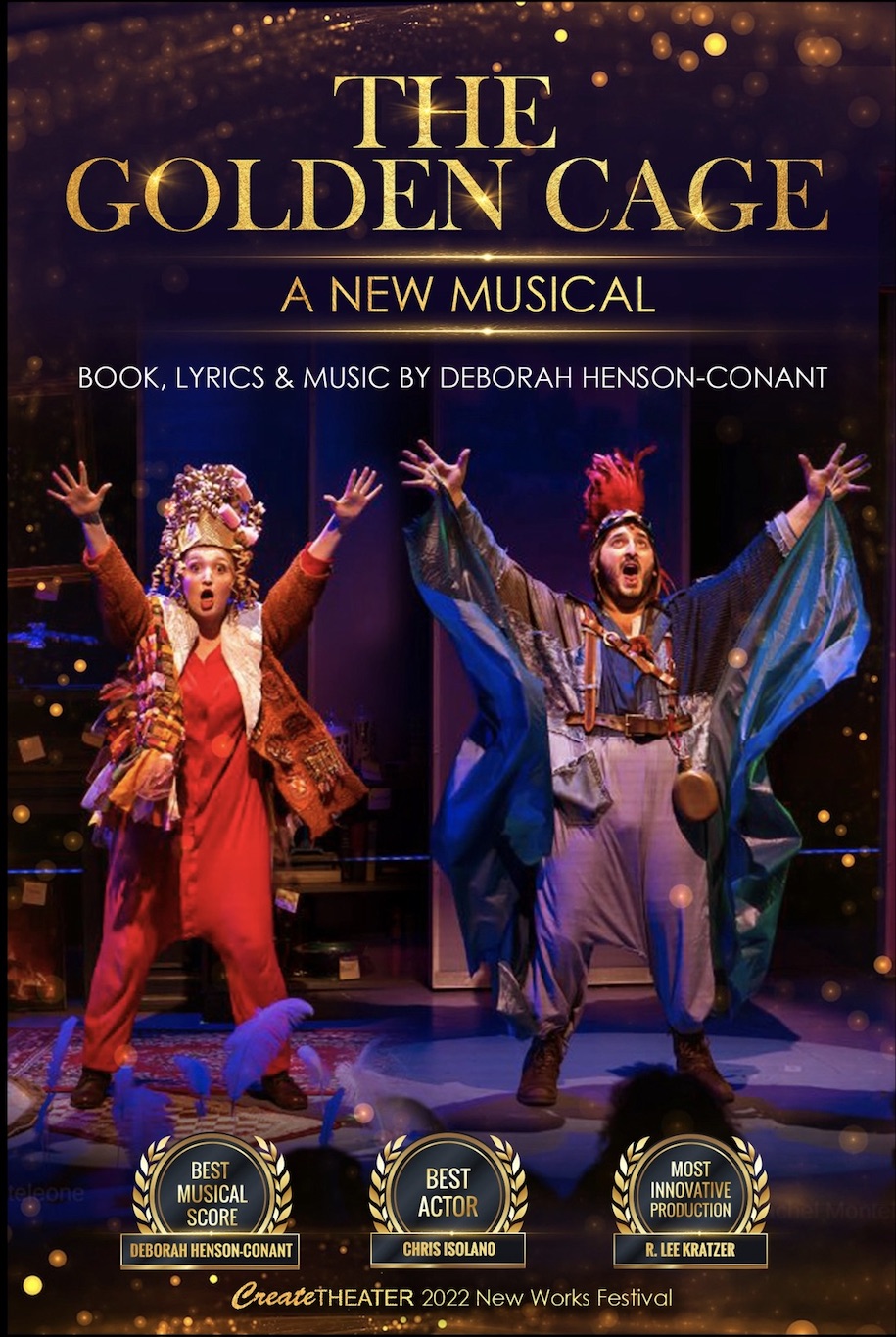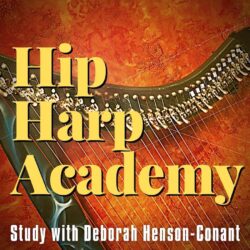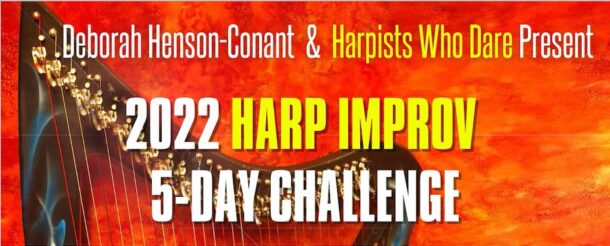Baroque Flamenco ~ Harp Concerto
REFRESH THIS PAGE so you’ll see the most up-to-date page

“Baroque Flamenco” is a stand-alone one-movement harp concerto
It’s also the 3rd movement of the 3-Movement Harp Concerto
“Soñando en Español” by Deborah Henson-Conant
The orchestral/concerto version of the piece score can be played with full symphony or with a smaller orchestra (i.e. strings, perc & pairs of winds & brass).
For practice and rehearsal, the harp soloists part comes with a piano reduction (purchase soloists part here)
The piece is also playable with Chamber Ensemble: Fl, Cl, String Quartet, Kb, Perc and Harp Soloist (this version is not yet officially available)
This is the Orchestral Information Page
This page is specifically for orchestras and soloists who are performing the “Baroque Flamenco” concerto. It gives you:
- An overview of what your license covers
- A definitive video of the score (with no cuts)
- The orchestration is and how to perform it with a reduced orchestra (i.e. with pairs instead of full winds & brass)
- How to credit the composer in programs
- Suggested cuts if you need to shorten the piece.
The video below is a performance of the piece with soloist Eleanor Turner and composer Deborah Henson-Conant conducting, with members of the Louisiana Philharmonic Orchestra.
ORCHESTRA INFO
2. The “Solo Harp Version” of this piece is different than the Concerto Version of the soloists part. It’s possible to play much (but not all!) of the Solo Harp Version when playing with orchestra, but rehearsal letters and measure numbers will not match up.
If possible, Harp soloists should use the “Concerto Soloists” part when playing with orchestra – but in cases where harpists have learned the Solo Version of the piece and there’s no time to relearn – there are some notes below on potential cuts and alterations that can make that work and you should ask the composer for the PDF called “How to Coordinate the SOLO HARP ARRANGEMENT (Advanced Version) with the CONCERTO-VERSION of Baroque Flamenco”
3. This is a video of the composer conducting the work with soloist Eleanor Turner. http://bit.ly/BF-NOLA-2014. This video is a useful reference because it’s the only recording of the piece as played exactly from the score/parts
LICENSING THE SCORE & PARTS for PERFORMANCE
To obtain a license/rental for score and parts to perform “Baroque Flamenco,” send an email to info@HipHarp.com with the following information:
We’d like to request a license to perform your “Baroque Flamenco” concerto. The performance is on [fill in the date] at [fill in the location] with [fill in the ensemble], and the soloist is [fill in the name of the soloist]. The latest date we’d need to receive the scores and parts is [fill in the date you need scores & parts]”
- You can often speed up the process by filling out the license information directly.
- The license/rental fee ($375) provides one-time license to use the parts & score to perform Baroque Flamenco which can include up to 3 performances within a 5-day period with the same soloist and ensemble .
- If you run into any problems, have questions or don’t get a response within 48 hours the fastest way to get the questions directly to us (and bypass possible spam filters) is to use the Ask-A-Question form.
CREDIT & OTHER THINGS FOR ORCHESTRAS TO KNOW
PROGRAM & PROMOTION
PROGRAM REQUIREMENT: Please send a scan or PDF of the program so we have it for our records. If you prefer, you can send a hard-copy program to:
Deborah Henson-Conant
Golden Cage Music
Box 1039
Arlington, MA 02474
PROMOTION: If you’d like the composer to promote your performance to her mailing list, send a basic short press blurb to info@HipHarp.com with a 600×600 dpi picture of the soloist (and/or the orchestra), and information about the date, time, ticket info and the name of the orchestra, soloist and theater.
VIDEO PERMISSION, CREDIT & TAGGING
VIDEO – ARCHIVAL USAGE: We encourage you to create archival video, and if you do, we request a copy and/or link.
YOUTUBE / SOCIAL MEDIA POSTING PERMISSION: You have permission to put video of your performance on YouTube or Facebook unless the composer requests you to remove it at some point in the future.
COMPOSER CREDIT & TAGGING: You must credit composer in any and every video, audio, print or other usage usage of this piece. If you post the video to YouTube or other social media, you must credit composer in the printed YouTube (or other) description
- “Baroque Flamenco” Concerto for Harp & Orchestra by Deborah Henson-Conant
- Optionally you can add: (Based on a Theme by Jean-Jacques Rousseau)
- Include a link to the composer’s website: HipHarp.com.
- If there’s any embedded text in the video (i.e. embedded text you must include the title and composer information on the video itself.)
NON-COMMERCIAL USE ONLY: You can use the video and audio for noncommercial purposes (i.e. you can use it promote yourself, or on your website but you will need to request permission before any commercial use – like using it on a recording, DVD, commercial, movie, etc.). NON-Commercial use includes using portions of rehearsal footage in promoting the concert and inviting local news to rehearsals or performances and to broadcast that footage as news or to promote the concert.
COMMERCIAL USE
COMMERCIAL USE: If you’d like to request other uses, email us at info@HipHarp.com and describe the additional use you’re requesting.
PROGRAM INFO
PROGRAM INFORMATION: Here is how you should credit it in the program (and on YouTube, etc. as above)
” Baroque Flamenco”
Concerto for Harp & Orchestra
(based on a theme by Jean-Jacques Rousseau)
by Deborah Henson-Conant
If your program requires dates or other info, here is additional composer information:
Composer: Deborah Henson-Conant (b.1953 / Stockton, CA)
OPTIONAL CUTS & ALTERATIONS
1. OPTIONAL CUT 1 (Cut all of Flamenco Variation 3):
In the 2007 broadcast and DVD version of this piece, we cut from the beginning of Letter [D] through the end of letter [G] (i.e. we cut 69-132)
2. OPTIONAL CUT 2 (Cuts within Flamenco Variation 3)
– A cut can be made from 161-208 (i.e. cut 4 measures before J and go directly to letter M)
– Or a similar cut can be made from 177-208 (i.e. cut 4 measures before K and go directly to letter M)
These won’t be seamless, but they can work to shorten the piece and expedite getting to the cadenza
3. OPTIONAL CUT 3 (251-258):
To shorten the ending it’s possible to cut m. 251-258
4. If the soloist has learned the ‘Harp Solo’ version of the piece and would prefer to retain as much of that version as possible instead of having to learn a new version, it’s possible to let the soloist play Letter [D] – [G] solo (no orchestra) and cue the orchestra to come in at letter [H]. The cueing is important because D-G in the solo part is a different number of measures than in the orchestral part! If the soloist tries to play what’s written in the “Solo” version with the orchestra, you’ll get a conflicting number of measures.
PARTS NUMBERS & ALLOCATION
| WOODWINDS | BRASS | PERCUSSION | STRINGS |
| 01 – Fl 1 (in later editions Picc) | 13 – Hn1 | 24 – Timp | 28 – Vn1 |
| 02 – Fl2 (in later editions Fl 1) | 13a – Hn1 Assist | 25 – Perc | 29 – Vn2 |
| 03 – Picc (in later editions Fl2) | 14 – Hn2 | 26 – Harp (Orchestral) | 30 – Vla |
| 04 – Ob 1 | 15 – Hn3 | 27 – Pno (Tacet) | 31 – Vc |
| 05 – Ob 2 | 16 – Hn4 | 32 – Kb | |
| 06 – EHn (Tacet) | 17 – Tpt1 | ||
| 07 – Cl1 | 18 – Tpt2 | ||
| 08 – Cl2 | 19a – Tpt3 | ||
| 09 – BCl (Tacet) | 19b – Tpt4 | ||
| 10 – Bn1 | 20 – Tbn1 | ||
| 11 – Bn2 | 21 – Tbn2 | ||
| 12 – Bn3 (Optional) | 22 – BTbn | ||
| 23 – Tba |
Here’s how to allocate the parts, depending on whether your orchestra has just pairs of winds and brass or is a full orchestra:
| <If playing with Pairs | <If playing with full orchestra |
| Piccolo play Piccolo/Fl. 3 part
Horn 2 play Horn 2/4 Part B Tbn play Tbn 1/2 Part |
Flute 1 & 2 play Flute 1 part Flute 3 play Piccolo/Fl. 3 part Contrabassoon play either Bn2 part or Tbn1 part Horns 1 & 3 play Horn 1/3 Part Tbn 1 play Tbn 1/2 Part |



